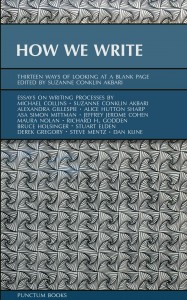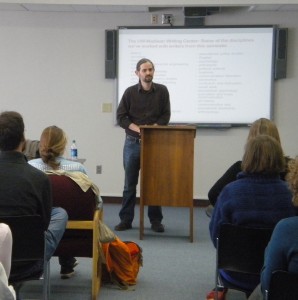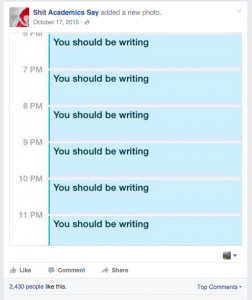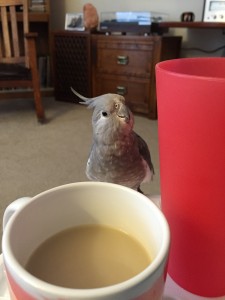By Leah Pope
Leah Pope has been a Writing Center tutor at the University of Wisconsin-Madison since fall of 2014. She is also a PhD candidate in English literary studies, writing a dissertation that explores representations of disability and bodily difference in Anglo-Saxon England.
Alexandra Gillespie opens her essay in How We Write: Thirteen Ways of Looking at a Blank Page by confessing that she only writes when she has to [1]. “Because reasons” (19). She writes this casually, as if she’s not breaking my mind by using Internet diction. But it’s not just her delightful, playful writing style — shared by many of the essays in this collection — that is revealing. Gillespie describes anxious and determined binge writing, fueled by deadlines ranging from a DPhil advisor’s note asking to have coffee — how terrifying! — to a paper promised to a friend/colleague for review. She describes writing 6,000 words in one day to meet a deadline — not drivel, mind you, but a conference paper and later the core of a book chapter.
My own writing process seems tame and much less exciting by comparison: I sit down; I type. Sometimes I need to doodle diagrams of ideas on a large piece of paper, or, in dire cases, on windows and mirrors in a dry-erase marker. A sentence or two will flow beautifully — the ones I have been turning over in my head while I fall asleep. But my academic career is not built on tweets (though if it were I might be closer to the coveted claim of “Digital Humanities” expertise), so I need to write more. Sometimes whole paragraphs at a time flow through my hands to the keyboard. Sometimes I write half a sentence here and there, framing in brackets things to write on a later day when my brain feels less like butternut squash. Sometimes the most interesting part of an essay comes to me when I am not actively writing at all, and gets copied and pasted out of an email I hastily type to myself using the WiFi at City Bar (a local establishment frequented by many a UW-Madison grad student). In these writing habits I am not always a good role model, but for now, these habits are functional enough for me and the way my brain works.
My goal in this blog post is to share some thoughts about neurodiversity as a surprisingly underutilized concept in writing instruction, and its potential implications for thinking about the writing strategies we teach and model for students. Anyone working on long-term writing projects can benefit from thinking about different approaches to the writing process. And anyone teaching or tutoring writers who seek advice on the writing process can benefit from hearing about the variety of possible approaches, so they can recommend more than solely their own approach.
Diverse Writers, Diverse Writing Processes
 How We Write: Thirteen Ways of Looking at a Blank Page, published last year by Punctum Books, began last May as a pair of blog posts: a PhD candidate’s thoughts following a roundtable on dissertation writing and the response that followed from a pair of tenured faculty. A flurry of online conversation ensued and within two months of the initial roundtable, the collection was coming together in its edited form. In September, my own printed copy arrived on my doorstep [2].
How We Write: Thirteen Ways of Looking at a Blank Page, published last year by Punctum Books, began last May as a pair of blog posts: a PhD candidate’s thoughts following a roundtable on dissertation writing and the response that followed from a pair of tenured faculty. A flurry of online conversation ensued and within two months of the initial roundtable, the collection was coming together in its edited form. In September, my own printed copy arrived on my doorstep [2].
How We Write offers thirteen essays by academics at all levels describing their writing processes with blunt honesty. Since reading it, I have been increasingly self-conscious about the secrecy we (academics, grad students, Writing Center tutors) often keep around our personal writing processes, as if we feel a kind of shame around what is working (or isn’t working) for us. We become very familiar with a few strategies — daily/scheduled writing, pomodoros, shitty first drafts — that show up again and again in composition classes and writing workshops, but outside of our own habits, we often hear very little about the more creative practices our colleagues have developed for their writing. And because our exposure to various approaches is limited, our students are unlikely to hear about the wide variety of writing processes that actually do work for a great many writing tutors who are themselves writers.
The narrative we spin through the mainstream writing processes we learn and teach is not always an accessible one. As Rick Godden’s essay in How We Write demonstrates, not all of us have the option of following a model of daily writing or scheduled writing periods. Physical realities make highly regimented writing rituals impractical, even impossible, for Godden, as well as a not insignificant number of our colleagues and students. Preferring or needing to use dictation or screen-reading software in order to write might mean that recommendations about drafting or revision practices sometimes simply won’t work or will be excessively time-consuming within that physical reality. Such diverse groups of writers — at the undergraduate, graduate, even professional academic level — are often left on their own to sort out an effective writing process, frequently without resources like the standard Writing Center conference, which does not easily accommodate accessibility software.
The physical realities of somatic diversity are mirrored in the often invisible realities of neurodiversity. A term coined only in the late 1990s, neurodiversity describes the variability of mental processes across different human minds. It is perhaps most prominent in the movement to recognize autism as a difference, even a benefit in some ways, rather than as a deficit. But neurodiversity can also include many psychological realities that a great many writers live and cope with: dyslexia, anxiety, depression, ADHD, PTSD, etc. These realities impact our writing processes and perhaps should impact the way we teach writing processes.
“Should”-ing All Over Ourselves

I would suggest that writing is always a neurodiverse process. Regardless of label-happy diagnoses, one “normal” writer, if there is such a thing, will always be different in some way than another “normal” writer. We already acknowledge this with matters of timing: I am a morning writer, but that is considered no better or worse than my friend who writes best in the middle of the night. The logic behind accepting and encouraging our students to explore writing at different times of day (in different settings, in different media, etc) could be extended to make advice about writing processes more accessible to a more diverse range of students. No one (to my knowledge) is saying that having difficulty following one writing process or another makes a student a bad or ineffective writer, but I don’t believe we are saying often enough that there are endless possible ways to write by which a person can be an effective writer.
Paul Silvia, in How to Write a Lot (APA, 2007), advocates for scheduled writing as a nearly universal solution to unproductive writing habits. He cites anecdotes and empirical studies, making a very compelling argument for why sitting down to write regularly will produce more new ideas and simply more words than only writing when one feels like it. His data suggests that this is true across averages. But we are doing a disservice to our students, our colleagues, and ourselves if we expect an average to mean everyone should be able to write that way. In addition to neuro- and physical diversity complicating the way any of us goes about writing, many of our students’ writing habits are complicated by work schedules (often a matter of socio-economic background), other courses (a matter of how different disciplines are socially and institutionally prioritized), and career expectations (which can be gendered and racialized through how much extracurricular/volunteer work is encouraged). No one approach to writing is going to be best — most efficient, most effective, most personally healthy — for every writer.

Scheduled writing may not actually be best for everyone, even if the numbers suggest it will be better for most writers. At the graduate and faculty level, the culture of academia widely demands almost constant writing, as is satirized by the Twitter and Facebook phenomenon Shit Academics Say. Such pressures almost certainly provide the encouragement that some writers need to get their work done, but when felt as a professional mandate, it just as certainly creates an unhealthy psychological environment for many other academics. Among graduate students (not uncoincidentally, the group that furnishes Writing Center tutors at UW-Madison), it is not difficult to find anecdotes about anxiety and panic attacks prompted by feeling that one should be writing more, better, and more often. Perhaps we would be happier, healthier, even more productive writers ourselves if we could become more willing to discuss our real and realistic writing habits openly with each other, to show each other not only that it is not mandatory to follow a single, narrow path to find success in academic writing, but also that there are a lot of creative options out there that are worth trying.
Writing instruction should likewise be informed by neurodiversity. When we make choices about syntax and diction, when we think about tailoring to our audience, we are attempting to communicate the ideas in our unique minds to a particular set of other unique minds. We are attempting to bridge the diversity of neural experience. Talking about neurodiverse needs and practices when it comes to the act of writing not only has the potential to create writers more attentive to their audience, but could also create a world more accepting of neurodiversity in other realms, such as conversational comfort zones, needs for more or less personal/social time, and different responses to kairotic spaces such as department receptions and office hours [3]. If we encourage our students to explore the writing practice that works best for their unique self without shaming unconventional processes, then we are also inviting them to seek support without embarrassment if their writing habits aren’t working — and we are declaring ourselves a safe resource for students who find themselves in any crisis affecting their schoolwork.
How We Write: Alone and Together
Suzanne Conklin Akbari opens her introduction to How We Write as follows: “When we write, we write alone. Being alone means control, productive solitude, introspective bliss; it also means loneliness, isolation, even fear” (xiii). I’ve heard it said on numerous occasions that anyone writing a dissertation needs a therapist. This is still probably true, but I suspect it’s more accurate to say that anyone who is writing at all needs someone they can talk to. This is a need Writing Centers can meet. By talking more to each other about our actual writing habits, as instructors, tutors, and frequent (or infrequent — whatever works for you!) academic writers, we can become better equipped to talk to our students about the diversity of writing practices that can and do work for different people.

For three months this fall and winter, I did not write alone. A cockatiel, Petey, would sit on the back of my chair, chew up sticky notes on my desk, or hop up to me on the couch and duck her head to ask me to scratch the back of her neck. She would leave little presents on drafts I set out to return to later. An earlier version of this blog post opened with a description of how her frequent distractions made me more productive by keeping me away from the endless vortex of the Internet. She passed away last week.
I mention this because, if we are being perfectly honest, my mind is in a different place now as I revise than it was when I first drafted this essay. My ability to research my dissertation — which is in fact very much about death — is in a different place. This is not exactly neurodiversity or somatic diversity; this is the diversity that is life (though really, isn’t all diversity just… life?). Our experiences define us even as they define our writing, and my sadness is changing the way I write. It would have felt dishonest to edit Petey out of this essay completely, because I know I’m not the only academic writer out there who has been stalled by the emotional experiences of their personal life.
I believe it would be good for us — as academics, but especially as Writing Center tutors and administrators at UW-Madison, around the country, and around the world — to talk more honestly about how we actually write. By sharing our psychological experiences of writing, we might just find our way toward happier, healthier, and more productive writing. Though it is not the only place this conversation should occur, I would offer the comments section below as a venue for sharing about our writing processes. How do you actually write? Do you tell your students the truth about your writing habits? And what’s the worst (or best) that could happen if you did?
Notes
[1] Try to understand my perspective on Alexandra Gillespie by imagining a scholar teaching at a university renowned for your field, who has published seemingly endless brilliant articles and books that you have cited repeatedly.
[2] Though I preferred to order the very reasonably priced print edition for myself, Punctum Books also offers How We Write free for download as a PDF.
[3] Margaret Price defines kairotic spaces in Mad at School: Rhetorics of Mental Disability and Academic Life as “the less formal, often unnoticed, areas of academe where knowledge is produced and power is exchanged” (60); in other words, spaces in which professional or academic success are contingent upon appropriate, often ostensibly casual, interpersonal interactions. The kairotic space of the writing conference calls for a blog post and conversation of its own.
References
Akbari, Suzanne Conklin, ed. How We Write: Thirteen Ways of Looking at a Blank Page. Brooklyn, NY: Punctum Books, 2015.
Silvia, Paul. How to Write a Lot. Washington, DC: American Psychological Association, 2007.
Price, Margaret. Mad at School: Rhetorics of Mental Disability and Academic Life. Ann Arbor, MI: University of Michigan Press, 2011.



Thank you for this thoughtful post, Leah! I particularly like how you draw our attention to the intersections of the revision process and ability. This reminds me some of Jessie Gurd’s post from a while back about writing off stage. Since that post, I have tried to normalize the idea that writing can happen anywhere: in the shower, on a run, doing laundry, watching a movie, writing an abstract, you name it. This concept of neurodiversity supports that idea and seems an important one for us to recognize.
I also agree with your idea that accepting neurodiversity has socioeconomic implications. About a year ago, I heard an undergraduate writing center tutor present research at a WC staff meeting on how much time UW students have for writing. I remember being shocked at how much time students spent working and how little time that left them for homework. These students didn’t have time to write more than one traditional draft. My response to this was to become even more committed to building in the revision process to an assignment, requiring drafts turned in earlier and practicing revision in class in order to give students this time. The question your post raises is whether, in doing that, I am ignoring the neurodiversity of my students by making them draft in a certain way. If I was, how can we balance neurodiversity and the desire to help our students experience the writing process or, perhaps, a writing process?
Thank you for your insightful response, Leah! I think you’re right to frame your question as a matter of balancing. How do we help our students write effectively without scaffolding such a rigid process that it becomes inaccessible for one reason or another? I wonder if a good middle ground might be to have students design their own assignment scaffolding as practice in developing their own process? That is, for a writing assignment with draft deadlines and in-class time built in, perhaps one could have the first assignment be for students to set their own timeline. The assignment could say they need to have at least a certain number of milestones, and determine which class days will be certain kinds of exercises related to the assignment that they can plan deadlines around. This would be more feasible in a composition classroom than a larger literature class in our department, but it might be a productive way to encourage students to take responsibility for their writing process, while also supporting them through figuring it out a little.
After having a few conversations with you about How We Write this fall, I’m so happy to see this wonderful post! I am in particular struck by your final section, which is a thoughtful reminder that life is a series of swerves and adjustments, and our writing is one component of our survival of and participation in those sometimes material alterations to the world. As tutors and teachers, we often say that writing is a means of thinking; writing practices, then, should probably not be treated separately from the ways in which thinking may—and does—change. This is a reminder I needed today!
Like you, my mind is in a different place with my current project than it was last time I looked at it. I’ve been staring at my screen or a sheaf of printed pages, puzzled by the spaces earlier me left now me to fill or close. After reading your blog post, I am thinking that I may need to forgive both selves for their differences and revise my way forward.
I also have some thoughts about the point Other Leah introduced in her comment (undergraduates have time for a single traditional draft) and how to assist students who begin their papers with one argument and then inadvertently work toward proving a different point altogether. Now me has not yet fully formulated my question/scenario/possible solution, but perhaps future me will have something coherent to offer.
Leah, That is a great piece. Thanks for sharing it so we could see it. As someone not properly trained to write, but one that has had to write a great deal in my career, I have been told my method is unorthodox. But it works for me.
Best time for me is mid morning, but I cannot have any distractions so I have to find a way to shut everything else out. Then I just write a stream of thoughts about the topic at hand. I don’t try to get them in any order or fit them in any plan. I then come back the next day and read it. Those thoughts may not necessarily fit in the piece I am writing, but when I read them again, it helps put the important parts into focus. Then I can piece together a good draft and let that set for a bit. Once I have done that, I will do a 2nd draft.
In my case, all of the work will go to an editor for comments and revisions before publication. I consider the hard work done once I send it to an editor because from there, it will simply be question and answer with that editor if I have a topic worth publishing.
I’m struck by Joe’s phrase, “not properly trained to write.” I find it a little ironic, because the process Joe describes actually includes some of the mainstream methods that we often encourage Writing Center students to try: writing a messy first draft, stepping away from a draft for a day or two, figuring out a time/context that works for your writing. It suggests to me that perhaps “proper training” is a myth, and that the role of a composition class or a writing conference is not to train, so much as to foster growth. I’m sure we’ve all seen students glide through a composition class with decent (or even good) grades, but without developing any further as a writer. Perhaps our goal, then, should not be to enforce a writing process, but to create an environment in which students are supported in developing their own writing process. This, of course, becomes also a problem of motivation, one to which I do not have an answer just yet.
On another note, Jessie is not the first person to point out that this conversation is a helpful reminder (others have contacted me off-blog) that writing is hard and weird, and life is complicated. I, for one, have every intention of being more vocal about both successes and challenges in my writing process, to keep open a space for friends and colleagues to have a cathartic outlet for their own writing-related experiences.
Like the other commentors, I too appreciate this honest look at how we [actually] write and the differences that everyone brings to their own writing process. Having recently transitioned from an academic to a professional graduate program and being slightly removed from the pressure of writing for an English Lit department, I feel more relaxed when I write than I did the last two years. I still agonize over words/organization once I’m in the final stages of my draft, but the middle part where I am actually writing is different. I suspect, however, that this is caused by knowing that I’m meeting different expectations now. Getting started on any draft is typically a challenge for me because I need to start at the beginning with an introduction. If I can’t introduce my topic, I don’t know how to properly proceed. Sometimes it takes days to get a “good enough” introduction so that I can dive into the binge writing that typically follows. Prior to this I have thought through the ideas I want to include, made note of them in random places (on my phone, on the back of a meeting agenda, in a notebook, etc.) and have a sense of how I want to move from one to the other, but without an introduction (even one which I know I will go back and change) I can’t get the rest out.
One of the many things I miss now that I’m not in Madison is not having a support group of writers like I did there. The support of my cohort, the writing center, and writing buddies (like Leah Pope!) were incredible assets to my writing success. I don’t have the opportunity to talk about my writing the same way now. And although I knew talking through my ideas and what was hanging me up with a draft was an important phase of my writing process, I didn’t realize how important it was until it wasn’t there any more.
I am working as a writing tutor now and that gives me an outlet to think about and talk about writing processes, though there are plenty of my students who don’t care about the process and only care about the final product. I try to be open and honest with them about the difficulties of writing, and I hope to add neurodiversity those conversations in the future.
Thanks Leah for an inspiring post and for sharing it with me!
P.S. I write best at night (anytime after about 7 pm and on to about 2 am) and with music in the background (my go-to Pandora stations are of piano music, like the Pride and Prejudice film score station I created last fall, or Of Monsters and Men), which I tune out about 30 minutes into a writing session, but which helps to mask apartment noises and other distractions.
Thank you, Leah, for this thoughtful post. I love the idea of foregrounding neurodiversity in writing instruction, and I’m sure these ideas will influence my teaching in the future. I’m also very sorry to hear about Petey — she seems like a wonderful writing companion.
In response to your closing questions, I want to offer this illustrative, but by no means complete list of the ways I have written:
–Curled in a blanket so that I could pretend I was relaxing
–In the very midst of telling myself, “I’m not writing; I’m just going to edit a little”
–In the middle of a jog, on my cell phone’s “notepad” app, with a high-intensity playlist blaring in my ears
–Repeating a particularly smart-sounding sentence to myself over and over until I can get the shampoo out of my hair, dry off, and write it down
–In 10-minute bursts between meetings
–At the library, which, like the gym, offers the anonymous company of weary fellow-travelers
–In writing groups
–In Writing Center workshops and sessions
–In a cramped hand in the margins of my books
–In the Scrivener app, which lets me think non-linearly
–In Word, which forces me to approach linearity
–On pieces of paper that I have laid out of my floor and literally cut and pasted together
–In different colors for different kinds of ideas
–In a deliberately chatty voice that would never pass muster in a formal academic paper, just to get over the hurdle of expressing my thoughts
–In PowerPoint first, so I can imagine how I would talk about my argument if I had to use only slides
–To an imaginary audience who are less intimidating than my actual audience
I imagine most of these are not uncommon strategies, but there are several I’ve never discussed with students. Doing so would involve admitting that I constantly have to find new ways to trick myself into putting words on a page — but would that be so bad?
Just a thanks for the lovely shout out! Great blog!
[…] the past week I’ve been mulling over this excellent post on Neurodiversity, Writing Process, And Writing Instruction by Leah Pope of the University of Wisconsin-Madison. She talks about how academia sometimes fails […]
Thanks for sharing this post, Leah. Tying writing to neurodiversity makes me think of work in comp/rhet about the means of persuasion available to people with mental illnesses, for whom writing is rarely taken as rhetorical but instead diagnostic by audiences without mental illness. I wonder if that could map on to writing processes, too. You might want to take a look at Catherine Prendergast’s essay “On the Rhetorics of Mental Disability” and the following essay by Melanie Yergeau in DSQ: http://dsq-sds.org/article/view/3876/3405
Thank you, all, for the illuminating comments! I’m beginning to love the idea of a writing collage/montage of Ways To Write, as inspired by Mattie’s style of listing the manifold places and ways writing happens. When a student asks, “How should I write?” [bracketing for now the fact that students rarely, if ever, actually ask that question — instead the problem presents itself in a dissertation that isn’t happening or class essays that are consistently too short or obviously procrastinated], I would like to be able to offer a flip book illustrating an endless variety of options. Then I would say, only very slightly tongue-in-cheek: “If you try to write and it isn’t working, try something else. *Anything* else.”
[…] see Explorations of Style here and here; do check out the How we Write collection; and see Another Word for a continuation of the […]
This is a wonderful post, Leah. I could not agree more:
“I don’t believe we are saying often enough that there are endless possible ways to write by which a person can be an effective writer.”
[…] not merely in attempt to respond to a call issued a few months back by my colleague Leah Pope, who, in a blog post that’s stuck with me more than I realized, wondered what it might look like to normalize talk about writing struggles. I suspect that many […]